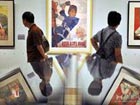| Videos | • Latest |
|
• Feature | • Sports | • Your Videos |
60 years of Chinese fine arts
Shao Dazhen, art critic, said, "The development of Chinese realism gained considerable headway in the period from l949 to l966 (after the liberation to the Cultural Revolution). The influence came from Soviet Union fine arts and Western countries. "
The year 1978 marked a turning point in history when the Reform and Opening Up policy was initiated. In the fine arts circle, the impact was tremendous.
Divorced from the fetters of politics, Chinese artists began to explore a new form of beauty. They combined exotic techniques and innovation to carry out rich and diverse Chinese art practices.
In 1980, at the Second National Youth Arts Exhibition, a portrait of a weather-beaten peasant caused a sensation among viewers. "Father" depicted a wrinkled old man, whose face and hands had been marred by years of labor. The painter Luo Zhongli applied natural color and photo-realism to depict an ordinary, sad old man in rural China, and in doing so, overturned the dictums of the "Cultural Revolution," which emphasized magnificence, happiness and positive themes. "Father" won first prize from visitors' votes. The image became a symbolic figure for the vast number of hoe-wielding Chinese peasants, the FATHER of a whole generation.
The rejection of artificial Cultural Revolutionary art and a turn towards earthly reality is all too familiar for Luo Zhongli and his generation of painters.
Then came Chen Danqing with his Tibetan Group Oil Paintings. The humanist emotions found in Chen's paintings show his deep understanding, compassion and respect for people at the bottom of society. The sentiments are given glorious and noble significance.
Fan Di’an, director of China National Art Museum, said, "Sixty years of change in society has offered artists common themes. In the fifties, both Chinese paintings and oils dwelt on subjects like history and socialist construction. In the eighties, after the reform and opening-up policy, their choice of subjects is much more diverse, covering all aspects of social life. Despite the variety of the subject matter, the artists have shared a common enthusiasm for their respective genre. Despite their own idiosyncrasies, the paintings collectively project the wholesome, innocent, sincere, and active stance of generations of Chinese artists."
In the 21st century, modern art has expanded rapidly, as shown in the prosperous auctions of contemporary Chinese art works. The "Big Family" series from Zhang Xiaogang has for example, won both kudos from critics and made big bucks internationally.
Chinese artists are increasingly seeking the humanism which was once lost, and nurturing an artistic spirit that fights for independence when globalization, marketization and institutionalization dominate the world. In more ways than ever, they are taking Chinese art to a new and sophisticated level.

 0
0 







Comments